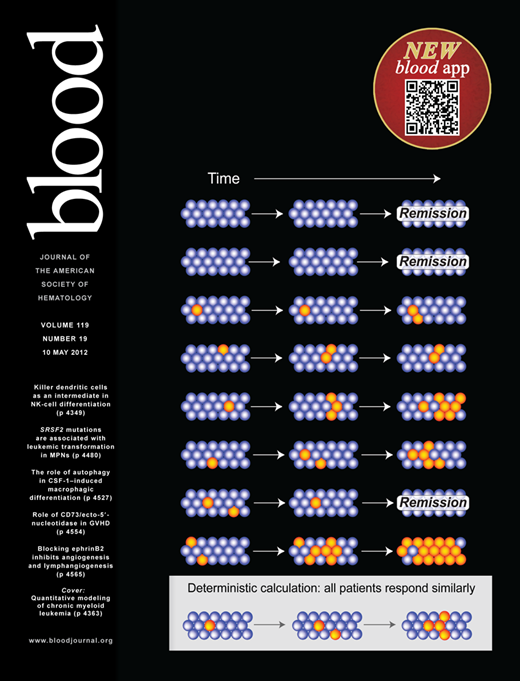The CD73/ecto-5′-nucleotidase dephosphorylates extracellular adenosine monophosphate (AMP) into adenosine. In this issue of Blood, Tsukamoto and colleagues demonstrate that adenosine produced by CD73 regulates alloreactivity after allogeneic hematopoietic cell transplantation (AHCT).1
After AHCT, graft-versus-host disease (GVHD) and the graft-versus-leukemia (GVL) effect depend on T-cell recognition of host alloantigens displayed at the surface of antigen-presenting cells (APCs).2-4 It is therefore crucial to understand the regulation of alloreactivity in AHCT recipients because alloreactive T cells are responsible for both the curative potential (GVL) and the most dreadful complication of AHCT (GVHD). Allogeneic donor T cells encounter dendritic cells and other APCs in secondary lymphoid organs of the host. The outcome of T-cell interactions with APCs depends on the maturation state of the APCs: immature APCs induce tolerance while mature APCs elicit effector T-cell responses.5 APC maturation depends on recognition of pathogen-associated molecular patterns (PAMPs; exogenous, microbial) or damage-associated molecular patterns (DAMPs; endogenous, nonmicrobial).6 Hence, initiation of GVHD and GVL must depend on PAMPs and/or DAMPs. Comprehensive studies of a variety of mouse mutants failed to reveal a role for PAMP-dependent pathways in GVHD.7 However, one DAMP released from dying cells, adenosine triphosphate (ATP), was found to play a key role in GVHD.8 Tissue damage caused by irradiation and GVHD increases extracellular levels of ATP. Moreover, expression of the ATP receptor P2X7R is up-regulated during GVHD, rendering APCs more responsive to ATP.8 As a result, binding of ATP to P2X7R in AHCT recipients induces APC maturation and enhances expansion of alloreactive effector T cells, whereas ATP neutralization or P2X7R blockade reduces GVHD mortality.
The abundance of extracellular ATP is regulated by CD39 and CD73 ectonucleotidases: CD39 dephosphorylates ATP to ADP and AMP, and CD73 dephosphorylates AMP into adenosine. Adenosine can bind to 4 subtypes of G-protein–coupled transmembrane receptors expressed by a broad range of leukocytes, including T cells and APCs. This report by Tsukamoto and colleagues demonstrates that CD73 deficiency (particularly in host cells) enhances alloreactive T-cell expansion and GVHD severity. The protective effect of CD73 on GVHD was probably mediated by A2A adenosine receptor signaling because A2A receptor deficiency increased expansion of alloreactive donor T cells. Therefore, after AHCT, ATP constitutes a danger signal whereas adenosine generated by CD73 favors tolerance induction. Of note, mesenchymal stromal cells express high levels of CD73 and many groups have reported that injection of these cells can decrease the severity of GVHD (a PubMed search on January 27, 2012 retrieved 98 articles on mesenchymal stromal cells and GVHD). CD73-dependent generation of adenosine might be instrumental in the pro-tolerance effect of mesenchymal stromal cells. Meanwhile, DAMPs other than ATP (eg, mitochondria and uric acid) may contribute to GVHD but their potential role has yet to be evaluated.
Tsukamoto and colleagues report a second novel finding: CD73 blockade enhances GVL activity against B-lineage leukemia cells.1 This result dovetails well with a series of recent reports on the role of ATP, P2X7R, adenosine, and CD73 in antitumor immunity.9-11 CD73 is overexpressed and P2X7R is down-regulated in various types of cancer cells compared with adjacent normal tissues of the same origin.9 Furthermore, treatment with anti-CD73 Ab inhibits mouse breast cancer growth and metastasis by inducing an adaptive antitumor immune response.10 Finally, after subcutaneous injection of tumor cells, CD73-deficient mice are resistant to primary tumor growth and to metastasis. The protective effect of CD73 ablation is dependent on CD8 T cells.11 Collectively, these reports are consistent with a T cell–dependent immunosuppressive effect of adenosine (and CD73) and a tumor suppressor role for extracellular ATP (and P2X7R). Whether signaling downstream of extracellular adenosine and ATP can be manipulated in such a way as to selectively enhance GVL (but not GVHD) remains a critical but unresolved question.
Conflict-of-interest disclosure: The author declares no competing financial interests. ■

